Meher Castelino visits the design studio of Sri Sri Radha Gopinath Mandir, popularly known as ISKCON at Chowpatty, and comes away impressed by the meticulous process followed by designers and artisans to create regal attires for gods and goddesses
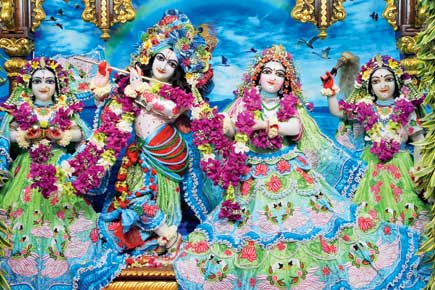
The term fashion usually conjures up images of models strutting the runway, flaunting latest creations of designers. But if you thought that a lot of thought and precision was given to clothes only for the ramp, then you are wrong.
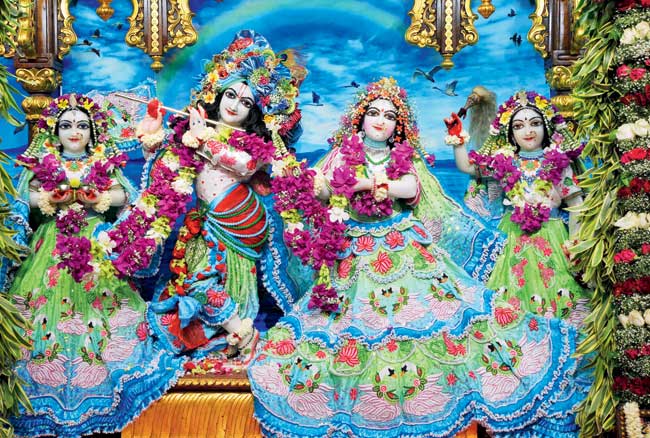
(Left and bottom) Embroidered with zardosi, aari, chikankari, gold and silver threads with Japanese pearls, Swarovski crystals, sequins, resham, the hand-painted dresses worn by the deities are a visual delight. Pics/ Meher Castelino
ADVERTISEMENT
Much work goes into dressing up gods at religious institutions, looking resplendent in regal attire, complete with a serene expression on their face as devotees throng to them in large numbers seeking divine intervention.
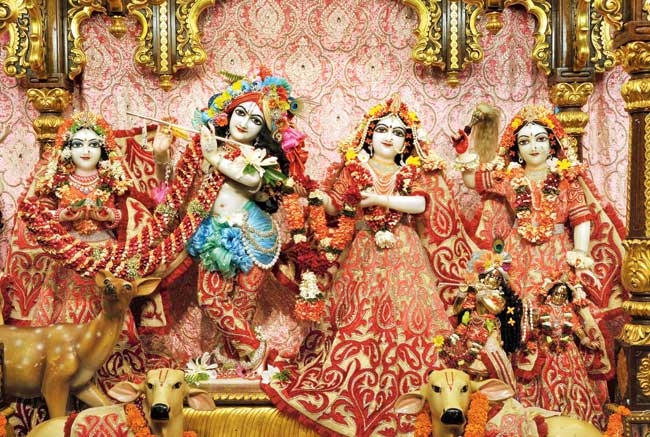
The Sri Sri Radha Gopinath Mandir, popularly known as ISKCON at Chowpatty, has a design studio where artisans work with clockwork precision, following briefs by designers, to dress up deities in the choicest of attire.
Following trends
One of the four ISKCON temples in Mumbai, the Sri Sri Radha Gopinath Mandir started operations in 1987 and the deities were installed in 1988. Dressing the nine deities (seven in the temple and two in the farm called Govardhan Eco village, 100 km from Mumbai) is a continuous process. Purushottam Das and Premkishor Das are in charge of the task.
“Initially we had a designer, Rekha Mafatlal (popularly known as Radhapriya Devi Dasi) in the temple), who created beautiful garments. In 2006-07, the design workshop, which was the brainchild of the late Gaurkrsna Das, Murlimohan Das and Gagan (all three passed away two years ago in an air crash) visualised the designing. Earlier we only designed the outfits but they were stitched and embroidered elsewhere. Now we have an in-house embroidery unit with craftsmen from West Bengal to supervise the quality,” informs Purushottam Das.

Artisans at work in the embroidery unit
A team of three designers follows current trends for the garments and ensures how they can be assimilated while maintaining tradition. The nine deities have day and night dresses — the former is worn before the 8 am aarti and the latter before the 8.50 pm aarti. Embroidered with zardosi, aari, chikankari, gold and silver threads with Japanese pearls, Swarovski crystals, sequins, resham and hand-painted, the dresses are a visual delight.
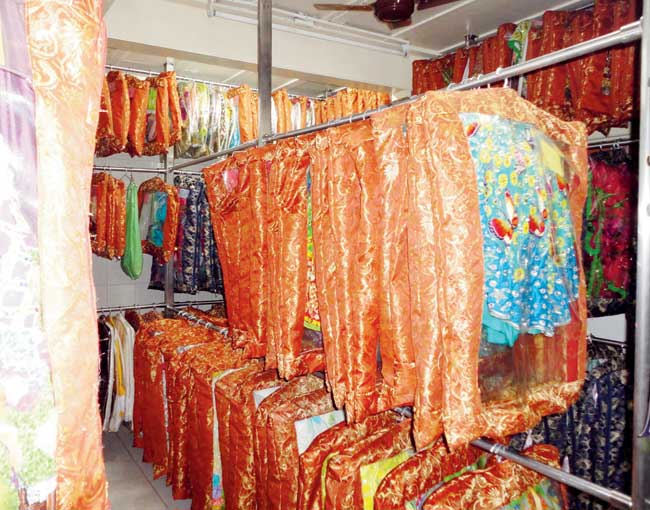
The wardrobe department has over 100 dresses, which are kept in order according to their styles
“We handpick the designers from among the devotees. We show them a small sample after which they create outfits for one of the temple’s seven festivals,” adds Premkishor Das. Experiments with colours, fabrics, which are procured from all over India, are an ongoing process.
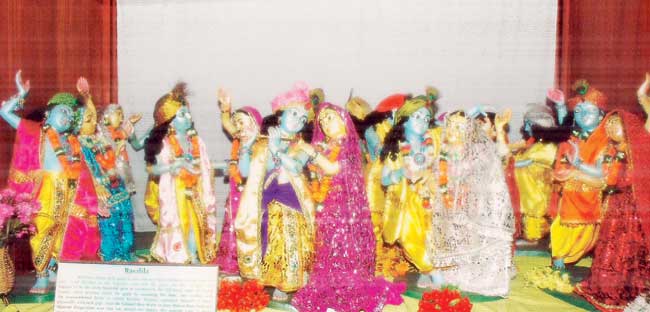
(Above and below) The dioramas depicting the various festivals where dozens of deities’ dresses are designed but changed twice a year
Catalogued perfectl
After the festivals, the garments, jewellery and accessories are catalogued, numbered, named and moved into the wardrobe department from where they are periodically reused. Fifty night and 70 day dressers select the outfits daily along with the specially- designed backdrops for the altar along with freshly-woven garlands and jewellery for the idols. The seven deities — Sri Nityananda, Sri Gaurchandra, Srimati Lalitadevi, Sri Gopinath, Srimati Radharani, Srimati Vishakhadevi and Srinathji — are permanently positioned from left to right. The other two deities — Srimati Radharani and Shri Vrindavan Bihari — are in the farm.
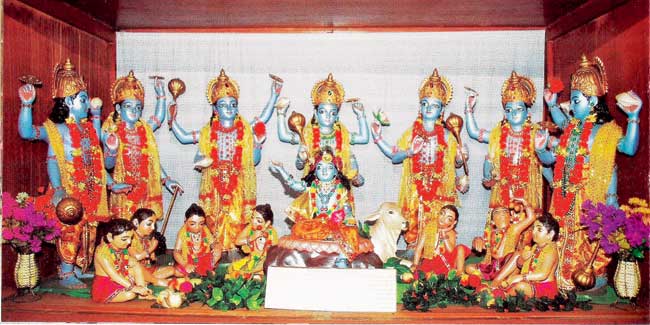
The wardrobe department has over 100 dresses, which are kept systematically according to the styles. “What is important is coordination between the designers of the clothes, who visualise everything, and the dressers who must know how the apparel needs to be draped. All outfits have Velcro with separate back/front openings for easy dressing,” informs designer Samira Shah who created grand outfits for the deities during Janmashtami.
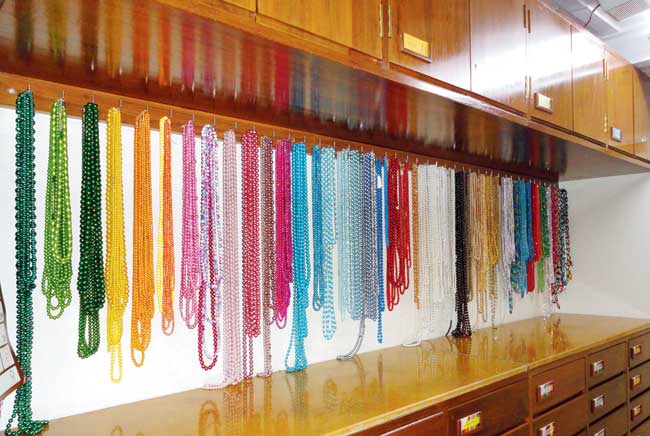
The jewellery department has beads in various hues and sizes
Challenges galore
A special group of ladies create floral garlands for the gods, keeping in mind the dress every day. The idols are also bedecked with Swarovski crystals, pearls and stones, including tiaras, which are gifted by devotees from Austria.
“There are several challenges — what may look good on a human being or in a sketch may appear completely different on the deity. Twelve to 13 sets are created for each deity during the seven festivals in the year. Deciding the concept is also a challenge, but once everything is finalised they are made within a month,” informs Shah. The altar is a vision of great beauty when the deities are dressed, keeping in mind every minute detail.
In the courtyard of the temple are 12 dioramas depicting the various festivals where dozens of deities’ dresses are designed but changed twice a year. All four ISKCON temples have separate design studios to dress the deities, which function in the same way.
So, the next time you pay obeisance to the Almighty in a temple, take a minute to observe the rich designs that adorn them and praise the designers who work diligently to achieve the same.
 Subscribe today by clicking the link and stay updated with the latest news!" Click here!
Subscribe today by clicking the link and stay updated with the latest news!" Click here!







